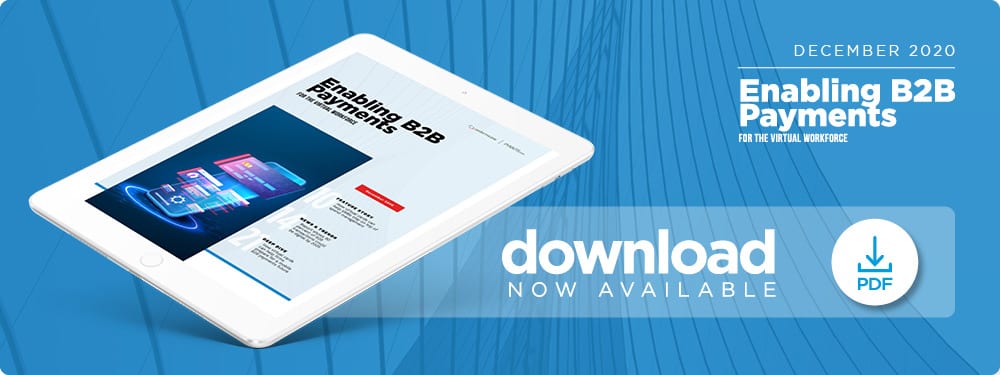Deep Dive: How Businesses Are Preparing Their Workers, Payments Operations For A Digital B2B Future

The COVID-19 crisis that began in March is leaving an indelible mark on the world. The World Health Organization (WHO) officially declared the outbreak to be a pandemic on March 11, but it took weeks for U.S. businesses and consumers to comprehend how dramatically the crisis would affect their lives and work habits. Office spaces closed and the employees who once occupied them headed home, where many have remained since.
Eight months have passed since businesses began a mass transition to remote working, but the effects of these moves are still rippling throughout the economy. Corporate budgets are getting smaller, consumers are limiting their spending and offices are more digital than ever. This is highlighting companies’ needs to reduce accounts payable (AP) and accounts receivable (AR) processes’ costs as well as to support daily expenditures for remote workforces. This month’s Deep Dive examines how mobile and contactless payment options are poised to reshape the corporate payments ecosystem as well as how virtual cards can help businesses adapt their operations to the digital-first payments ecosystem that has emerged.
Reshaping Business Payments
B2B businesses have historically been slower to adopt digital innovations than the consumer sector. Consumers have used digital payments technologies such as digital wallets, cards on file and mobile banking apps, to make purchases for years, but the average business organization was still using checks to settle 42 percent of its supplier payments in 2019. This reveals how slowly businesses have proceeded when digitizing payments as well as the extent to which they have relied on paper-based, manual methods.
However, the pandemic is marking a major turning point for payments innovation. Much of the U.S. workforce shifted from working in offices to working from home when states and cities began implementing stay-at-home and shelter-in-place orders in late March, and 23 percent of employees are still working their full-time jobs from home. Firms with remote employees have to improvise to keep their payments operations running smoothly. This has often entailed doing away with paper-based payments in favor of cloud-enabled AP and AR solutions that professionals can access from their laptops, computers, mobile devices and tablets to process expenses online.
Businesses’ shifts to support their remote workforces are also reverberating across the rest of the B2B ecosystem and opening the door to digital supplier payments. Seventy-six percent of SMBs in North America report that the pandemic has prompted them to enhance their digital capabilities and 82 percent say they are changing how they send or receive payments to or from other businesses.
Many businesses’ and organizations’ AP operations adjustments have been geared toward coping with the current economic predicament, but they are likely to make a permanent shift regarding the ways in which payments are dealt. Research shows that roughly 40 percent of businesses plan to let their employees work remotely in the future, meaning that these firms must have digital infrastructures in place to support them.
Adapting To A Mobile, Contactless Normal
Adopting digital payment operations is only the first step to succeeding in the rapidly evolving digital-first B2B ecosystem. Firms must also ensure that their new operations are efficient and position them for long-term success, and virtual cards can help. These tools offer operational benefits that can support remote workforces, reduce payment costs and enhance firms’ abilities to monitor and forecast their cash flows. Virtual cards can improve employees’ user experiences for everyday professional purchases, whether workers are operating remotely or on business trips. Cards can be sent directly to employees’ smartphones via banks’ or companies’ AP portals, while plastic corporate cards must be distributed in advance and could be misplaced.
Virtual cards’ features can also endear them to corporate accounting departments. It costs nothing to issue virtual cards and many issuers even provide monthly rebates as incentives to companies that use them. Cards can also be integrated into companies’ broader enterprise resource planning (ERP) infrastructures and issued to vendors and employees without manual intervention. This means that virtual cards can be used for supplier payments as well as employees’ everyday expenditures and they can be automated to reduce long-term operational costs.
Another benefit of virtual card issuance and payment functions is that they give businesses greater insights into their AP and AR operations. Virtual cards that are connected to businesses’ ERP systems can transmit information about where payments are in the transaction process, allowing for end-to-end visibility into firms’ payment flows and helping cash flow managers make more informed financial decisions about cash flows and credit.
Companies across the nation have been faced with unprecedented financial and logistical challenges, leading them to seek cost-effective, decentralized digital processes and payments, and they value enhanced cash flow visibility more than ever before. Virtual cards address these needs and are uniquely poised to enhance businesses’ AP and AR operations and prepare firms for long-term growth in the new, digital-first economy.

